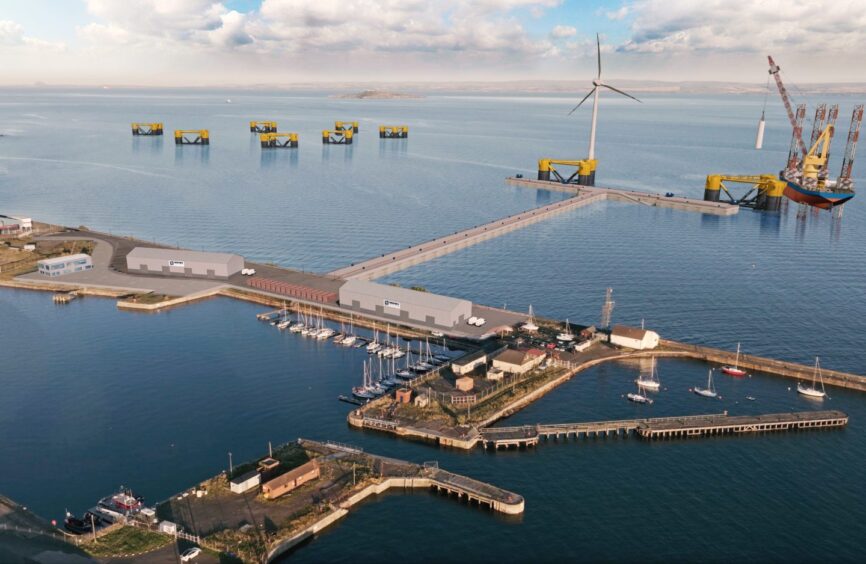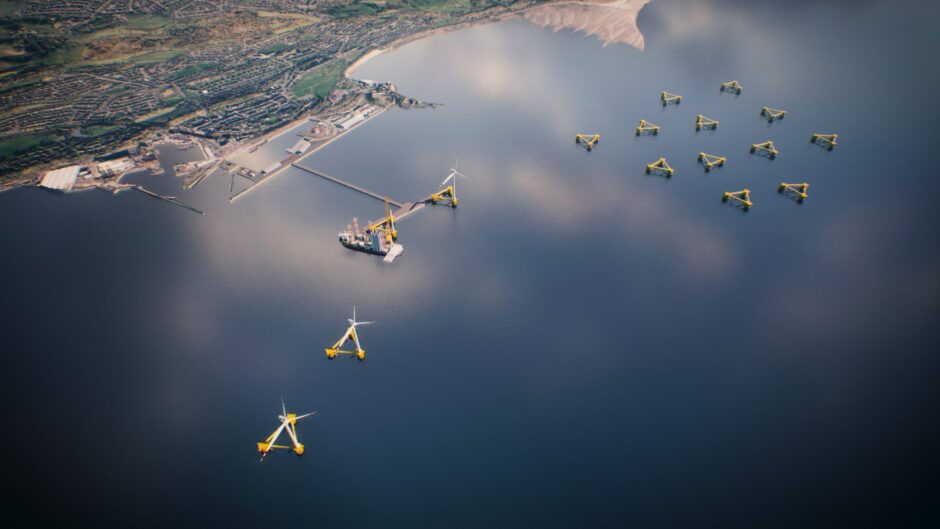
Forth Ports says its vision to use both sides of the Firth of Forth to store, assemble and commission floating wind turbines could see more than £100 million invested at the site.
The port operator outlined plans in October for an integrated floating offshore wind facility at the Port of Burntisland in Fife, as part of its wider bid to create “Scotland’s largest renewable energy hub”.
During a tour of the Port of Leith renewables hub, just four miles across the estuary, Forth Ports director of energy David Webster this week put further flesh on the proposals, outlining the ways in which the two sites would work in tandem to deliver Scotland’s floating wind ambitions.
“When you get into the later Scotwind projects, they’re all floating, so the foundation will be a floater.
“What you need to be able to do is install the turbine on it before it gets taken out – and what Burntisland effectively enables is the ability for us to do that in a safe, controlled environment,” he explained.
Under the plans, floating foundations would be stored and marshalled with turbine components at the Leith hub, before being towed across the Forth to a commissioning facility at Burntisland next to the former BiFab site.
A T-shaped berth would then allow crews to walk out and work on two floating turbines at a time, carrying out commissioning in a matter of days before the units are towed out for offshore installation.
“Burntisland provides the market with a facility that works, and a facility that will enable high deployment rates, because it’s not just a case of doing one demonstrator – you’re looking at putting hundreds of these out every single year to hit the Scotwind targets.
“You need a facility that can do high capacity,” Mr Webster said.
“We reckon it’ll be three days per unit, so basically every six days you’re putting two out – you can work out how quickly you can deploy them.”
That would be twinned with other proven methods for pre-assembly using a wind installation vessel, he says, and the promise of effectively “unlimited” storage for foundations across both sides of the Firth.
“All that ties together, and it’s really good for this market. It’s basically looking at realistic delivery of Scotwind in the future.”
Investment could top £100m
The proposals are currently in the early engineering stage, though Mr Webster suggests delivery of such a facility could require investment in excess of £100 million.
“At the moment we’re going through the front end engineering design (FEED) stage. We at Forth Ports are funding all of that, we’ve got a lot of studies to basically get a full design so that we can then move forward with consenting it.”
Once consented it would examine a potential build programme, ahead of delivery in the early 2030s, in time to meet the needs of floating projects.
The blueprint comes as Scottish Enterprise has tasked Edinburgh-based Norvind to project-manage the creation of a new body in charge of creating a single Scottish offshore wind cluster.
Similar assembly-line production plans for floating turbines have also been proposed at Ardersier in the north east.
Leith berth due online in August
Meanwhile the new £50m outer berth and marshalling space at Leith continues to progress.
Since Energy Voice’s last visit in June 2023, pile installation the construction of a rear sea wall and retaining wall has continued – though being submerged he concedes “a lot of the progress is invisible”.
Despite a recent run of poor weather, he says the development remains on track for opening in August 2024, at which point it will be ready to serve the growing market.
“We’ve got a number of active opportunities that we’re working through and I would expect the first project that will be completed out of Leith will be towards the end of this year,” he added.
Further work is locked in later this decade for BP and EnBW’s 2.9GW Morven wind project, the bid for which included a seven-figure investment in the port itself.
And despite the upsets of CfD rounds and finance hurdles across the wider wind industry, he remains confident in both the level of demand and Forth Ports ability to meet it.
“We’re quite fortunate – investing ahead of demand de-risks it for projects. With Leith we’ve given ourselves a level of buffer between when the project started and when we complete, so it’s quite comfortable.”
With that will come the rest of the hub ecosystem, in the form of supply chain and technology firms looking to serve the wind industry.
“There’s a lot of things going on in the renewable sector with Contracts for Difference and various different stages of [project] consents; once they start progressing because everybody’s got confidence in the infrastructure, you’ll then see a lot of the supply chain starting to set up in Edinburgh,” he added.
“There’s a little bit of chicken and egg, because you need the projects.
“But once that happens, we’re ready – and the supply chain will follow.”
Recommended for you

 © Supplied by Forth Ports Group
© Supplied by Forth Ports Group © Supplied by Forth Ports/Jamie Si
© Supplied by Forth Ports/Jamie Si © Supplied by Forth Ports/Jamie Si
© Supplied by Forth Ports/Jamie Si